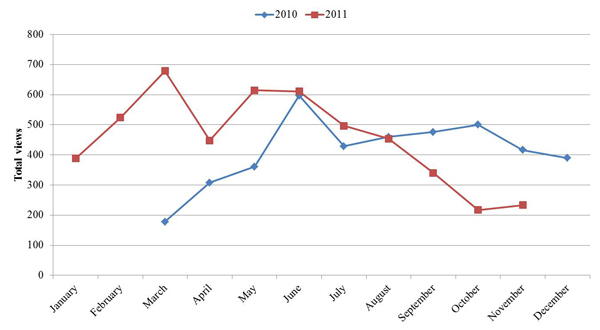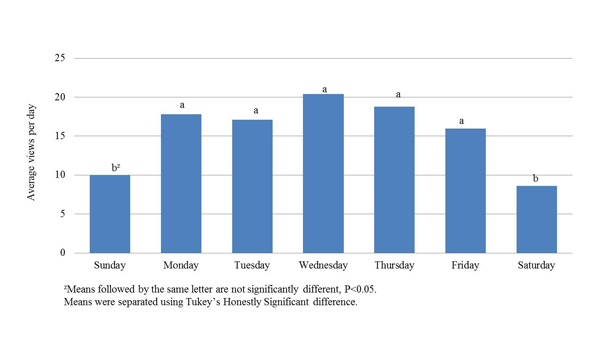 |
December 2012
|
December 2012 // Volume 50 // Number 6 // Tools of the Trade // v50-6tt3
Viticulture Education via Blogging
Abstract
Extension educators must become creative to increase impact at a reduced cost. A blog from the Oklahoma State University viticulture and enology program through Wordpress engaged industry members about grape growing. The most views were during March and June, important months in the season. Off-season months (October through January) resulted in fewer readers. Views were consistent throughout the workweek, but declined during the weekend. A visual complement to a blog entry, such as a photo, may encourage readers to view content. Overall, the blog expand the reach of the Oklahoma viticulture and education program at no added expense.
Introduction
Blogging is a new way for Extension educators to engage large audiences with timely and relevant information (DiPietro & Miller, 2009). Blogs allow Extension educators to communicate directly with their audiences, delivering timely information and initiating online conversation in a collaborative learning environment (Williams & Jacobs, 2004; Jones, Kaminski, Christians, & Hoffmann, 2011).
In March 2010, in response to an earlier assessment of the Oklahoma viticulture and enology program (Stafne, McGlynn, & Mulder, 2009), a viticulture blog was initiated through Wordpress (www.okgrapes.wordpress.com) to engage industry members in conversation about grape growing and act as an educational tool. The perceived audience for the blog was limited to about 60 wineries in Oklahoma and perhaps 100 grape growers, with most being vineyards between two and five acres.
Data Collection
All data were collected through the Wordpress site. Important statistics used in the study were:
- Search terms
- Top posts
- Clicks
- Comments
- Views
Data for individual number of views per day were recorded manually from 1 June 2010 through 31 October 2011. All other data were collected from 17 March 2010 through 30 November 2011. Data were analyzed with ANOVA using JMP 9.0 (SAS, Cary, NC) in the Fit Model procedure. Tukey's Honestly Significant Difference was implemented for mean separations.
Results and Discussion
Using a blog site that tracks data can be very useful for the author. The reported data can document the origin of the online traffic as well as what search topics that lead readers to the blog (DiPietro & Miller, 2009; Jones, Kaminski, Christians, & Hoffmann, 2011). In the case of the blog discussed here, the synonymous varieties Cynthiana and Norton were searched for 69 times. Even though this variety has been around for more than 100 years, a renewed interest was evident among grape growers in Oklahoma and surrounding states. The term "berry shrivel" (or some close modification thereof) was the number two-searched item. Shriveling berries is a common problem with many possible causes and is obviously an area that requires more time in educating growers but also in researching causes and developing solutions.
The data for top posts is another way the author can gauge the topics of greatest interest. In topic-based posts, the top two matched the search terms (Cynthiana/Norton and berry shrivel). Third was table grape production. Controversial posts can also create more readership, as evidenced by the fourth top post, "Spanish Varieties? Malbec? Read On" where the author points out the lack of cold hardiness and general poor performance of these varieties in north central Oklahoma. This report led to discussion in the comments section and generated the most comments.
On several posts, a link was made available to lead the reader to more information. Surprisingly, these links did not generate many clicks. The top link provided was for the Oklahoma State University viticulture and enology program (www.grapes.okstate.edu), with only 22 clicks, followed by the Midwest Small Fruit and Grape Spray Guide (21 clicks), and www.eViticulture.org (19 clicks). These low numbers may indicate that readers do not have the time or desire to read more than a short blog entry.
Figure 1.
Total Views per Month in 2010 and 2011 for the Oklahoma Viticulture Blog

Date of the month (1-31) had no effect on blog readership (P=0.61). Year-to-year average daily views were not significantly different either, although 2011 averaged slightly more than 2010 (15.7 vs. 15.3). The data may have been skewed because of the reduced readership after the announcement of the blog's end on 30 August 2011 and the last blog entry on 22 September 2011 (Figure 1). The blog was viewed a total of 9,118 times from 17 March 2010 until 30 November 2011.
Jones, Kaminski, Christians, and Hoffmann (2011) stated that agriculture-related blogs can be subject to seasonal influences. That was evident for the viticulture blog as well. The most views were generated starting in February, when pruning is typically started, through August, when harvest begins and/or ends for most varieties (Table 1). The most views were generated during the months of March and June, two of the most important time periods of the season. Off-season months (October through January) resulted in a decline in readers.
| Month (2010/2011) | Average views per day | Season Comments |
| January | 12.5 bcz | Dormant season |
| February | 18.7 abc | Cold damage most likely during this month |
| March | 21.9 a | Pruning, pre-budbreak spraying |
| April | 14.9 abc | Budbreak, bloom |
| May | 19.8 ab | Cover sprays, training |
| June | 20.1 a | Pre-fruit ripening canopy management, training |
| July | 14.9 abc | Fruit ripening, harvest begins |
| August | 14.7 abc | Prime harvest month |
| September | 13.6 bc | Harvest continues |
| October | 11.6 c | Harvest ends, season over |
| November | 13.9 abc | Dormant season |
| December | 12.6 bc | Dormant season |
| zMeans not followed by the same letter are significantly different, P<0.05. Means were separated using Tukey's Honestly Significant Difference. | ||
Reader views were consistent throughout the workweek, but declined during the weekend. The busiest day generated 86 views, but the average was far fewer (Table 1). The number of views crested mid-week and fell to the lowest point by Saturday (Figure 2). Two potential reasons could explain this: there were no new posts on the weekend and/or usual readers were away from their computers.
Figure 2.
Average Views by Day of the Week for the Oklahoma Viticulture Blog

Five percent of the entries contained photos. Photos were often related to classes or "breaking news" information like winter injury. The average views for an entry containing a photo was 21.9, compared to 15.1 overall. The sample size was not large enough to make a definitive statement on whether photos encouraged greater readership, but the data does show an increase. Thus, a visual complement to the blog entry may encourage readers to view the content.
Conclusions
Writing a blog can be a rewarding experience, both for the author and reader. An engaging blog allows the author to become more familiar to the audience, breaking down barriers between the university and the grower (Williams & Jacobs, 2004) and creating trust between the parties on a more personal level.
However, blogs are not without challenges. Conflicting reports on the effectiveness of reader engagement exist in terms of education-related blogging (Kim, 2008); yet even blogs that are only read, but not contributed to by the reader, are important learning tools (Williams & Jacobs, 2004; Kim, 2008). A blog that is infrequently updated risks losing its audience (Jones, Kaminski, Christians, & Hoffmann, 2011), so dedication to the task is imperative.
Overall, the blog expanded the reach of the Oklahoma viticulture program at no added expense other than the author's time. Growers and prospective growers could access the information on a daily basis or in the archives. Therefore, blogging by Extension educators can help fill the need of reaching intended audiences with research-based, timely information via a cost-effective method that requires a small, but frequent, time commitment.
References
DiPietro, L., & Miller, M. (2009). Extending expertise through conference calls and blogging. Journal of Extension [On-line], 47(6) Article 6TOT6. Available at: http://www.joe.org/joe/2009december/tt6.php
Jones, M. A., Kaminski, J. E., Christians, N. E., & Hoffmann, M. D. (2011). Using blogs to disseminate information in the turfgrass industry. Journal of Extension [On-line], 49(1) Article 1RIB7. Available at: http://www.joe.org/joe/2011february/rb7.php
Kim, H. N. (2008). The phenomenon of blogs and theoretical model of blog use in educational contexts. Computers & Education 51:1342-1352.
Stafne, E. T., McGlynn, W. G., & Mulder, Jr., P. G. (2009). Post-course evaluation of a grape management short course. Journal of Extension [On-line], 47(3) Article 3RIB4. Available at: http://www.joe.org/joe/2009june/rb4.php
Williams, J. B., & Jacobs, J. (2004). Exploring the use of blogs as learning spaces in the higher education sector. Australasian Journal of Educational Technology 20:232-247.




